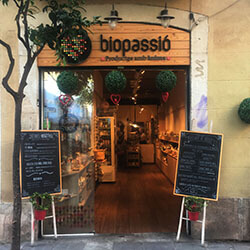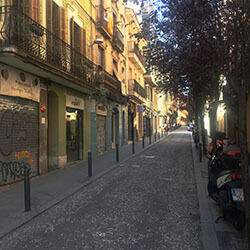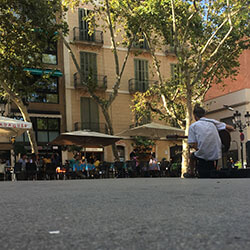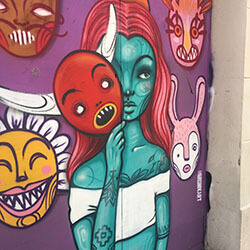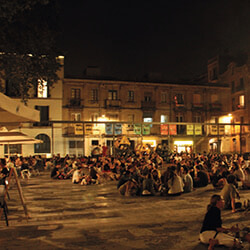The neighbourhood of Vila de Gràcia is the heart of the Gràcia district in the northern part of Barcelona, about five kilometres away from the city centre. The territory itself has a long-standing history and was independent in the past. Knowing the history of the neighbourhood is crucial to fully comprehending today’s Vila de Gràcia. After two long phases of independence Gràcia was eventually incorporated as a suburb of Barcelona in the year 1897.
This historically independent background manifests itself in the visual appearance of the streets and houses. Vila de Gràcia is characterized by numerous small, narrow streets and alleys, as well as by a multitude of inviting squares. But it is not only the visual impression of the neighbourhood that reflects its former independence; it also depicts the residents’ ideas of Gracienc identity and a sense of belonging to the neighbourhood.
Today’s Vila de Gràcia is still known as the ‘village in the city’ and is famous for its relaxed bohemian atmosphere, vibrant bars and gastronomy, its great art scene and its sustainable lifestyle. It is one of the most densified neighbourhoods in Barcelona with currently 50,670 residents, composed of young families, students, many older long-time residents and a high number of foreigners (1).
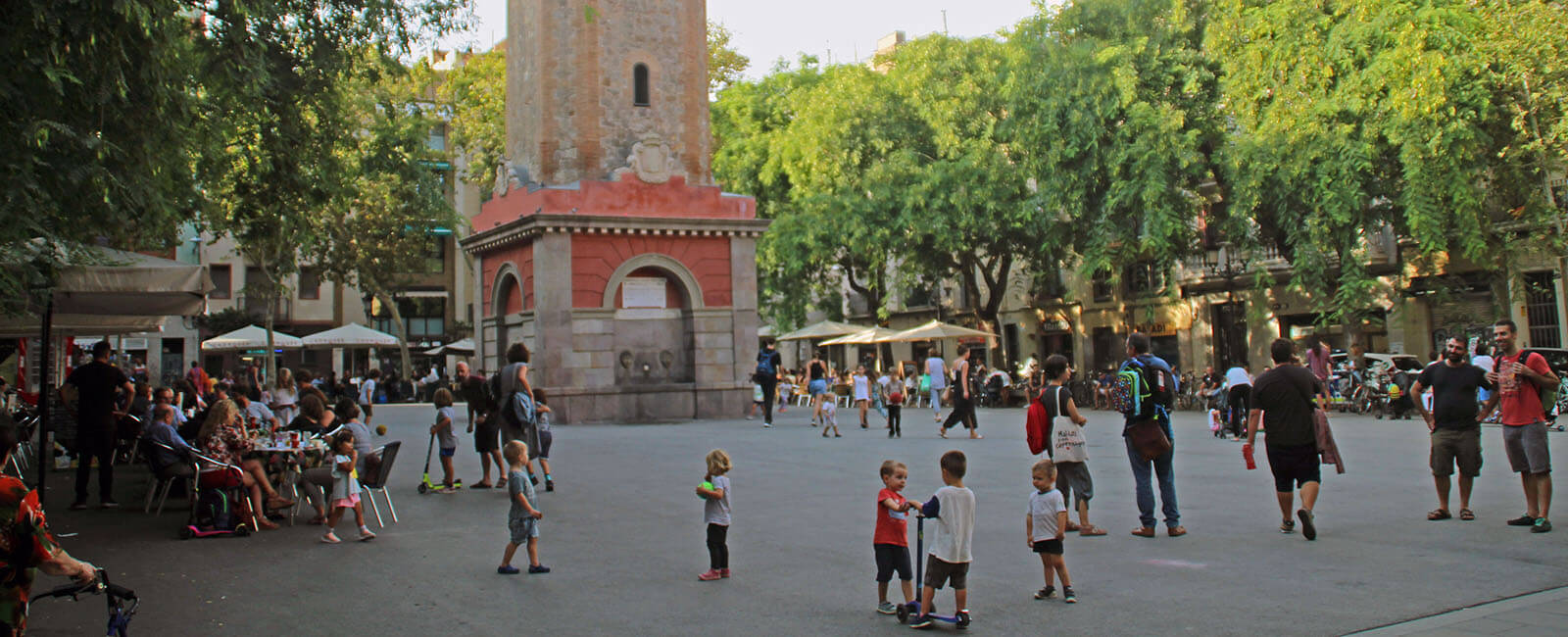
Vila de Gràcia
A Village in the City
Aim of the Project
Currently the neighbourhood faces various challenges and constant change with a multitude of actors pulling and exerting pressure on Vila de Gràcia. This situation is intensified by an increase in flourishing tourism. While other districts of Barcelona have already been overrun by mass tourism, a steady increase in the number of tourists can be observed in Vila de Gràcia as well.
The aim of this study is to explore the causes, effects and characteristics of the rise of tourism in Vila de Gràcia, and to describe local negotiation processes. An important objective is to determine which phase of the touristification process Vila de Gràcia is currently in, and which causes and forms of tourism can be observed. In addition, the impacts of tourism on the neighbourhood are examined. In this context it is especially the voices of the locals which are of interest. Their voices represent local perceptions of tourism developments and how these transformations are being experienced. We are interested in how increasing tourism is influencing the local identity and community in Vila de Gràcia.
To answer these questions, interviews have been conducted with local residents, members of neighbourhood organizations, hotel employees, tourists and other actors. Finally, we outline potential action approaches and consider future perspectives.
The aim of this study is to explore the causes, effects and characteristics of the rise of tourism in Vila de Gràcia, and to describe local negotiation processes. An important objective is to determine which phase of the touristification process Vila de Gràcia is currently in, and which causes and forms of tourism can be observed. In addition, the impacts of tourism on the neighbourhood are examined. In this context it is especially the voices of the locals which are of interest. Their voices represent local perceptions of tourism developments and how these transformations are being experienced. We are interested in how increasing tourism is influencing the local identity and community in Vila de Gràcia.
To answer these questions, interviews have been conducted with local residents, members of neighbourhood organizations, hotel employees, tourists and other actors. Finally, we outline potential action approaches and consider future perspectives.
Causes for Rising Tourism in Vila de Gràcia
In order to understand the rise of tourism which is taking place in Vila de Gràcia, the starting point is to identify the causes of this development. Besides the fact that Barcelona itself is a tourist magnet, there are two main factors that have contributed to the recent increase in tourism in this neighbourhood.
The local identity and perceived image of the ‘village in the city’ can be identified as the first main cause, while the second is linked to ongoing transformation processes in the neighbourhood.
These two phenomena, which will be examined more closely, are working as pull-factors for tourism and leading to a steady increase of tourist numbers in Vila de Gràcia.
The local identity and perceived image of the ‘village in the city’ can be identified as the first main cause, while the second is linked to ongoing transformation processes in the neighbourhood.
These two phenomena, which will be examined more closely, are working as pull-factors for tourism and leading to a steady increase of tourist numbers in Vila de Gràcia.
The Gracienc Identity
Despite the loss of its independence and its integration into Barcelona, the neighbourhood and its inhabitants feel a strong bond to its independent village roots. Phrases like ‘When we need something, we go down to Barcelona’ are often heard from local inhabitants. They reflect the individual, spatial location of the residents as part of Vila de Gràcia and their felt separation from Barcelona. When we asked locals about their associations with the neighbourhood, their answers were similar. In the first video we hear words like ‘traditional’, ‘neighbourhood life’ and ‘village’, and many residents say that ‘home’ is strongly associated with Vila de Gràcia. These voices on the streets reveal the understanding and perceptions of the locals in respect of their neighbourhood and their common sense of identity. ‘We identify ourselves with Vila de Gràcia. We know each other. ´Hello, good morning. How are you? It's a very familial neighbourhood’, says Pedro, a long-term resident.
Concepts of identity based on a place, as in Vila de Gràcia, are a common phenomenon in neighbourhoods with a long history. The linkage of place and identity is intensified by an emotional component creating an identity which applies not only to single individuals but also to all kinds of social groups (2). In our interviews with residents, we found that people’s perceptions and descriptions of their life and their bonds to Vila de Gràcia match these initial impressions from the street. There is a strong sense of cohesion, and the revolutionary character that has emerged from an activist past is reflected today in the social movements of the neighbourhood.
However, it should be noted that the identity that is attributed to the neighbourhood by the residents is not fixed or uniform, but is always marked by a degree of subjectivity. Thus, identities like that of Vila de Gràcia are formed over time in a dynamic and continuous process involving new sensations and perceptions.
Concepts of identity based on a place, as in Vila de Gràcia, are a common phenomenon in neighbourhoods with a long history. The linkage of place and identity is intensified by an emotional component creating an identity which applies not only to single individuals but also to all kinds of social groups (2). In our interviews with residents, we found that people’s perceptions and descriptions of their life and their bonds to Vila de Gràcia match these initial impressions from the street. There is a strong sense of cohesion, and the revolutionary character that has emerged from an activist past is reflected today in the social movements of the neighbourhood.
However, it should be noted that the identity that is attributed to the neighbourhood by the residents is not fixed or uniform, but is always marked by a degree of subjectivity. Thus, identities like that of Vila de Gràcia are formed over time in a dynamic and continuous process involving new sensations and perceptions.
The Gracienc Identity
Vila de Gràcia in Transition
Cities, and neighbourhoods in general, are subject to constant dynamic processes of change and transformation. Vila de Gràcia is currently undergoing socio-spatial and socio-economic transformations which act as a pull factor for tourism.
A significant upgrading of the neighbourhood has taken place in recent years through urban reconstruction measures which have given the district a new image. For example, five squares in Vila de Gràcia were redesigned in 2014 in order to increase the attractiveness of public space. This newly created modern and alternative image is slowly establishing a new residential class. Many of these new residents come from other European countries. While in 1991 only about 1.5% of the residents of Vila de Gràcia were foreigners, by 2018 the figure had risen to 21%. According to Barcelona City Council Statistics Department, this new middle class also contributes to the fact that the average income of residents has increased (1).
These urban development upgrading measures and the change in the population structure has led to rising land and rent prices. Between 2014 and 2017, the rental price per square metre in Vila de Gràcia rose from 11.25 euros to 15.01 euros per month, which is higher than the average rent in Barcelona (3).
Changes in retail and gastronomy can also be observed. There is a new focus on the expanding lifestyle, leisure and entertainment market, with organic restaurants, fair trade shops or art galleries, for example. These supply the needs of the new residents, as Riki from the left-wing youth organization Arran explains in the interview below. Overall, commercial activities in Vila de Gràcia have increased, while industrial activities have decreased, according to the Barcelona City Council Statistics Department (1). This development shows that the former working-class district has developed into a ‘hip’ residential area.
A significant upgrading of the neighbourhood has taken place in recent years through urban reconstruction measures which have given the district a new image. For example, five squares in Vila de Gràcia were redesigned in 2014 in order to increase the attractiveness of public space. This newly created modern and alternative image is slowly establishing a new residential class. Many of these new residents come from other European countries. While in 1991 only about 1.5% of the residents of Vila de Gràcia were foreigners, by 2018 the figure had risen to 21%. According to Barcelona City Council Statistics Department, this new middle class also contributes to the fact that the average income of residents has increased (1).
These urban development upgrading measures and the change in the population structure has led to rising land and rent prices. Between 2014 and 2017, the rental price per square metre in Vila de Gràcia rose from 11.25 euros to 15.01 euros per month, which is higher than the average rent in Barcelona (3).
Changes in retail and gastronomy can also be observed. There is a new focus on the expanding lifestyle, leisure and entertainment market, with organic restaurants, fair trade shops or art galleries, for example. These supply the needs of the new residents, as Riki from the left-wing youth organization Arran explains in the interview below. Overall, commercial activities in Vila de Gràcia have increased, while industrial activities have decreased, according to the Barcelona City Council Statistics Department (1). This development shows that the former working-class district has developed into a ‘hip’ residential area.
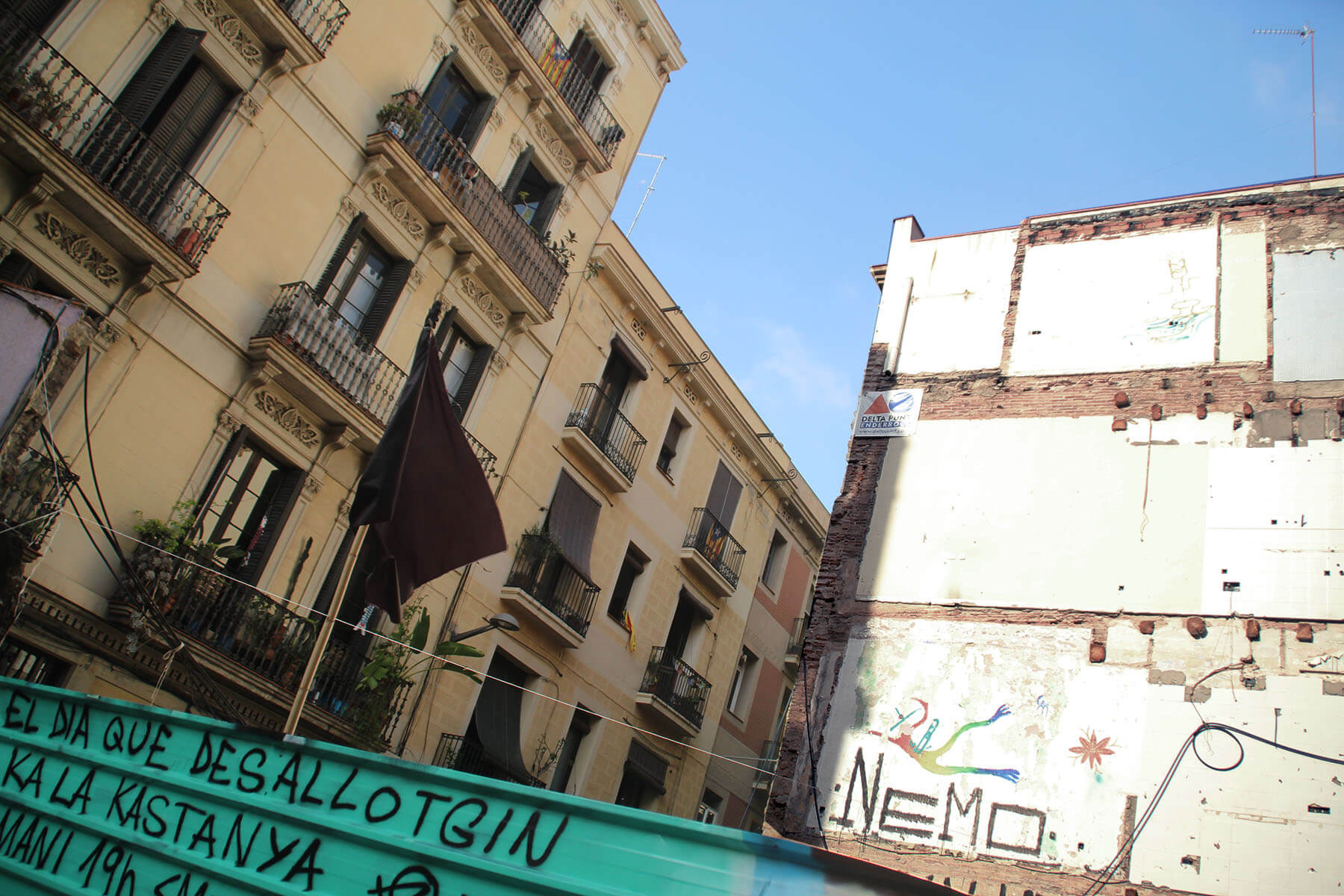
Areas in Transition
Such targeted measures to create living and working spaces for ‘creatives’ and wealthy middle classes, which have set a process of gentrification in motion, act as pull factors for tourism. Thus tourism is spatially extended to newly developed safe urban spaces with a bohemian middle-class atmosphere. This shows that tourism increases through gentrification, as places become more attractive to visitors. Eventually, the tourism growth engine relies on these urban transformations to accumulate capital continuously. In return, tourism intensifies gentrification (4).
Rising Tourism in Vila de Gràcia
While in districts such as Barceloneta or El Born the process of touristification is at a high peak, Vila de Gràcia is still in an early phase of transformation. Touristification can be defined as the gradual development of a neighbourhood into a space used for tourism with simultaneous displacement of existing forms of use. This process does not manifest itself homogeneously and simultaneously in all districts of Barcelona (4).
Barcelona's profile as a tourist destination is of great economic importance, so that attractions are constantly being reinvented. Thus, locations outside the so-called tourist bubbles of Barcelona are becoming the focus of attention, and tourism is now expanding into areas which were previously characterized as urban peripheries, including working-class neighbourhoods like Vila de Gràcia. This trend results in a decentralization of tourism. This process can be actively controlled by urban policy in the sense of placemaking, which aims to produce certain images (5).
This development of growing tourism in Vila de Gràcia is also reflected in the statistics. While economic activity in the tourism sector was just 4.8% in 2012, it rose to 14.6% by the year 2018 (1). One of the factors contributing to this situation was the significant increase in the number of facilities available for tourist accommodation. It is important to note that the number of beds in collective facilities like hotels, guesthouses or hostels is significantly lower than in peer-to-peer accommodation, like Airbnb. In most other parts of the city, the proportion is vice versa. This means that housing space is taken away from its original purpose and therefore less and less housing space is available. Official statistics from the city government document show that in 2016 there were around 1,500 peer-to-peer accommodations in the whole district of Gràcia with about 6,000 beds. More than 420 of these were illegal (6, 7). Looking more closely at the Airbnb data, it can be seen that there are currently 1,018 Airbnb listings in Vila de Gràcia. With more than half of these being entire apartments, it can be assumed that they are exclusively used for renting purposes (8). Taking just these two statistics into account, it is quite obvious that the situation in respect of tourist accommodation is unclear and intransparent at the moment.
Barcelona's profile as a tourist destination is of great economic importance, so that attractions are constantly being reinvented. Thus, locations outside the so-called tourist bubbles of Barcelona are becoming the focus of attention, and tourism is now expanding into areas which were previously characterized as urban peripheries, including working-class neighbourhoods like Vila de Gràcia. This trend results in a decentralization of tourism. This process can be actively controlled by urban policy in the sense of placemaking, which aims to produce certain images (5).
This development of growing tourism in Vila de Gràcia is also reflected in the statistics. While economic activity in the tourism sector was just 4.8% in 2012, it rose to 14.6% by the year 2018 (1). One of the factors contributing to this situation was the significant increase in the number of facilities available for tourist accommodation. It is important to note that the number of beds in collective facilities like hotels, guesthouses or hostels is significantly lower than in peer-to-peer accommodation, like Airbnb. In most other parts of the city, the proportion is vice versa. This means that housing space is taken away from its original purpose and therefore less and less housing space is available. Official statistics from the city government document show that in 2016 there were around 1,500 peer-to-peer accommodations in the whole district of Gràcia with about 6,000 beds. More than 420 of these were illegal (6, 7). Looking more closely at the Airbnb data, it can be seen that there are currently 1,018 Airbnb listings in Vila de Gràcia. With more than half of these being entire apartments, it can be assumed that they are exclusively used for renting purposes (8). Taking just these two statistics into account, it is quite obvious that the situation in respect of tourist accommodation is unclear and intransparent at the moment.
As already mentioned, Vila de Gràcia has played a rather inconspicuous role in Barcelona's tourism scene so far. But although it has no important tourist attractions or world famous sights, tourism is steadily increasing here. So what exactly is it that attracts more and more tourists to the neighbourhood? And what kind of tourism can be observed in Vila de Gràcia?
New Urban Tourism
On closer inspection, one type of tourism emerges as the most prominent: New Urban Tourism, also known as off-the-beaten-track tourism. Tourists of this type are often in search of a foreign daily routine, the particularity of the local and a high level of authenticity and individual experience, through which they can expand their own cultural capital. Therefore, instead of staying in the classic tourist zones of Barcelona, they orientate themselves specifically towards urban peripheral neighbourhoods. Vila de Gràcia is a perfect illustration of New Urban Tourism, as travellers seek to experience the true authenticity of the neighbourhood and to gain a unique travel experience. (9, 10, 11)
When we asked tourists on the streets in Vila de Gràcia to describe the neighbourhood in a few short and intuitive words, which can be heard in the middle of the first video, the reactions were highly consistent. Adjectives like ‘authentic’, ‘friendly’ and ‘small’ are frequently used to point out the village character of the district. But descriptions such as ‘not that crowded with tourists’ were also mentioned, confirming the availability of off-the-beaten-track experiences the New Urban Tourist is aiming at. At first glance, tourism in Vila de Gràcia does not seem as tangible and visible as in other parts of the city.
It is precisely this sense of neighbourliness and the fact that Vila de Gràcia has its own identity that meets the ideas and desires of the New Urban Tourist. Many small boutiques, restaurants and cafés, as well as numerous squares, contribute to a quiet and peaceful neighbourhood life. A closer look at the commercial establishments shows that there are no classical souvenir shops tailored to the specific needs of tourists. Instead, the tourists use the local commercial and gastronomic infrastructure. The vibrant artistic scene and the ecological and sustainable lifestyle also contribute strongly to this image. Furthermore, the relaxed nightlife with numerous small bars is a magnet for tourists and a strong contrast to the typical well-known party spots of the city. Especially the Plaça del Sol becomes a meeting point when the sun sets. Students, young families and locals gather on the Plaça to enjoy the evening together. Tourists often join in these everyday practices of the locals and thus merge temporarily into the village life of Vila de Gràcia.
It is precisely this sense of neighbourliness and the fact that Vila de Gràcia has its own identity that meets the ideas and desires of the New Urban Tourist. Many small boutiques, restaurants and cafés, as well as numerous squares, contribute to a quiet and peaceful neighbourhood life. A closer look at the commercial establishments shows that there are no classical souvenir shops tailored to the specific needs of tourists. Instead, the tourists use the local commercial and gastronomic infrastructure. The vibrant artistic scene and the ecological and sustainable lifestyle also contribute strongly to this image. Furthermore, the relaxed nightlife with numerous small bars is a magnet for tourists and a strong contrast to the typical well-known party spots of the city. Especially the Plaça del Sol becomes a meeting point when the sun sets. Students, young families and locals gather on the Plaça to enjoy the evening together. Tourists often join in these everyday practices of the locals and thus merge temporarily into the village life of Vila de Gràcia.
Alejandro, hostel employee: Description of local tourism
As Alejandro reports in the interview, an important point for the New Urban Tourist is the type of accommodation, with classic hotels or guesthouses playing a negligible role in this neighbourhood. In general, such tourists prefer the peer-to-peer accommodation offered by Airbnb. The concept of renting out rooms outside the common tourist housing infrastructure, in order to give tourists a unique experience, perfectly fits the expectations and aims of New Urban Tourists.
Changes related to Tourism and Local Perceptions
In discussions with local actors it becomes clear that the increase in tourism is intensifying the current transformations, especially gentrification, in the neighbourhood. The changes are assessed differently by different actors, although it should be pointed out that perceptions are always subjective. It is important to note that many people don’t perceive any strong effects, positive or negative, because tourism is not very present for them in their neighbourhood. This observation confirms that the process of touristification in Vila de Gràcia is still in its infancy.
Other residents, who are aware of an impact, report positive aspects such as the upgrading and revitalization of the neighbourhood. For example, they think that without these transformations there would be fewer bars and cafés. Employees or owners of gastronomy establishments also confirm that their sector benefits from tourism; they rarely speak of problems with tourists, but rather see an opportunity to offer international food, to ‘think outside the box’. However, other residents see the development of gastronomy as negative because prices are rising. In the retail sector the situation is similar. While retail owners benefit from tourism, others are critical about the establishment of new businesses and rising prices. Nevertheless, many residents understand that tourists come to Vila de Gràcia because of the beauty and the atmosphere of the district, and they show their neighbourhood with pride, as Belen, a student and local resident, says in the second video.
Other residents, who are aware of an impact, report positive aspects such as the upgrading and revitalization of the neighbourhood. For example, they think that without these transformations there would be fewer bars and cafés. Employees or owners of gastronomy establishments also confirm that their sector benefits from tourism; they rarely speak of problems with tourists, but rather see an opportunity to offer international food, to ‘think outside the box’. However, other residents see the development of gastronomy as negative because prices are rising. In the retail sector the situation is similar. While retail owners benefit from tourism, others are critical about the establishment of new businesses and rising prices. Nevertheless, many residents understand that tourists come to Vila de Gràcia because of the beauty and the atmosphere of the district, and they show their neighbourhood with pride, as Belen, a student and local resident, says in the second video.
Besides positive aspects, the growing tourism in Vila de Gràcia and the related transformations also have negative effects. The problem most frequently mentioned by interlocutors is the increase in rents, the transformation of housing into tourist accommodation, which often happens illegally, and the construction of luxury apartments and hotels. Gerard from the Oficina L’habitatge Popular de Gràcia, a housing organization, addresses these problems in the second video and criticizes the resulting displacement of the neighbours. This is endorsed by surveys conducted by the Gràcia Citizens' Office. Most residents identify tourism, housing and noise as the biggest problems in the district during the past four years (12). Some residents say that family members or friends have had to move out of their homes because rents increased enormously after their old contracts expired. Another neighbour complained that there is only tourist accommodation left in his housing complex, so that he has no direct neighbours anymore. It is precisely this displacement of long-term residents, which goes hand in hand with gentrification, that impacts on the identity and cohesion of the neighbourhood.
Other problems, such as disturbance by increasing noise and waste, especially at the Plaça del Sol, have increased. The blame for this is put not only on the tourists, but also on the behaviour of the local population, of which residents like Belen are aware.
Another point at which an early state of touristification in Vila de Gràcia can be observed is the Festa Major. This festival takes place every year for a period of one week. Weeks in advance, residents prepare the elaborate decoration of their streets. The festival has its origin in the year 1850, when Gràcia was recognised as an independent municipality for the second time. For a long time, it was considered as an expression of local identity. In the meantime, it has developed into a global event which is promoted internationally and attracts big crowds of tourists. In conversations it becomes clear that the inhabitants feel deprived of their original tradition, and therefore rate the increasing number of tourists as negative. In addition to the specific effects on the neighbourhood, the residents have become more aware of the general effects of tourism over time. This includes, for example, the fact that tourism creates jobs, which is positive on the one hand, but negative on the other, because it is mostly precarious work and the wealth generated by tourism is unequally distributed, as Riki explains in the following interview.
Another point at which an early state of touristification in Vila de Gràcia can be observed is the Festa Major. This festival takes place every year for a period of one week. Weeks in advance, residents prepare the elaborate decoration of their streets. The festival has its origin in the year 1850, when Gràcia was recognised as an independent municipality for the second time. For a long time, it was considered as an expression of local identity. In the meantime, it has developed into a global event which is promoted internationally and attracts big crowds of tourists. In conversations it becomes clear that the inhabitants feel deprived of their original tradition, and therefore rate the increasing number of tourists as negative. In addition to the specific effects on the neighbourhood, the residents have become more aware of the general effects of tourism over time. This includes, for example, the fact that tourism creates jobs, which is positive on the one hand, but negative on the other, because it is mostly precarious work and the wealth generated by tourism is unequally distributed, as Riki explains in the following interview.
Riki, a member of Arran, the local youth organisation: A critical view of increasing tourism in the district
Vila de Gràcia Defends Itself
Some residents express their criticism and dissatisfaction in respect of the growing tourism described above, as well as other ongoing urban transformations. As a result, several organizations have been founded in recent years which fight for democratic co-determination and participation in designing the neighbourhood, for affordable rents, and against the displacement of residents by tourism, as can be seen in the second video and also heard in the interview with Riki. Alba, an employee at the cultural centre of Vila de Gràcia, perceives the militant tendencies in the neighbourhood as being very strong: ‘The people here mobilize a lot. We operate together like a clan. We are fighting to maintain the identity of the neighbourhood and to ensure that its history won’t disappear’.
In many conversations it becomes clear that the majority of residents are not against tourism per se, but against the current tourism model, which in their opinion places economic interests above those of the inhabitants.
The protests of these groups are expressed for example through stickers and graffiti with messages such as ‘Tourism kills the city’ or ‘El barri no està en venda’ (The neighbourhood is not for sale), or through various activities and demonstrations.
In particular, an empty building plot has been decorated with graffiti and a poster with the inscription ‘Gentrificació ens expulsa, Gràcia es defensa! (Gentrification expels us, Gràcia defends itself!) Tourism kills the city’, which very clearly demonstrates the resistance put up by the local people. The building that previously stood on the property was owned by a big real estate company, which wanted to build a luxury hotel there. Thereupon, members of the L'habitatge organisation and other residents occupied the house for two years before it was evacuated violently by the police and finally demolished by the company. Demonstrations against gentrification regularly take place under the slogan ‘Desalojos son disturbios’ (Evictions are riots).
In many conversations it becomes clear that the majority of residents are not against tourism per se, but against the current tourism model, which in their opinion places economic interests above those of the inhabitants.
The protests of these groups are expressed for example through stickers and graffiti with messages such as ‘Tourism kills the city’ or ‘El barri no està en venda’ (The neighbourhood is not for sale), or through various activities and demonstrations.
In particular, an empty building plot has been decorated with graffiti and a poster with the inscription ‘Gentrificació ens expulsa, Gràcia es defensa! (Gentrification expels us, Gràcia defends itself!) Tourism kills the city’, which very clearly demonstrates the resistance put up by the local people. The building that previously stood on the property was owned by a big real estate company, which wanted to build a luxury hotel there. Thereupon, members of the L'habitatge organisation and other residents occupied the house for two years before it was evacuated violently by the police and finally demolished by the company. Demonstrations against gentrification regularly take place under the slogan ‘Desalojos son disturbios’ (Evictions are riots).
Different attitudes to local tourism
It must be considered that tourism is a complex and dynamic system and that feedback effects arise as a result. This means that tourism influences its social, economic, ecological and political environment and is influenced by it at the same time (13).
Dealing with Tourism
Vila de Gràcia is currently in the phase where it is necessary and still possible to act in order to achieve a balance before touristification is further strengthened. Currently, various positive aspects of tourism can still be discerned. In order to prevent these being overruled by negative effects, new ways to deal with tourism need to be found.
One of the most important points is to establish participation processes for the residents, so that they can have a say in designing their environment. This would mean that the needs of tourists are not placed above those of residents.
With regard to tourist accommodation, there are regulations that have been set up by the city of Barcelona. The Plan Especial Urbanístico de Alojamiento Turístico, adopted in 2017, prohibits the granting of new licences for tourist accommodation in some districts, including Vila de Gràcia. Instruments to tighten controls in order to combat illegal accommodation have also been developed (14). This ban on new tourist accommodation, including Airbnb, should be extended to the construction of new hotels, hostels, etc. It would also help, for example, to prohibit the advertising of guided tours or sightseeing routes that lead through Vila de Gràcia. By prohibiting the advertising of events like the Festa Major, or attractions in the sense of placemaking, increasing tourism flows can be avoided.
For the inhabitants it is important to remain aware of the positive effects of tourism, and to remember that the unwelcome changes are due not only to tourism, but also to other urban transformations which have led to the district becoming a very attractive residential area. The inhabitants also need to remember that the identity of spaces has never been rigid, but is constantly changing.
Finally, it would be important to raise the awareness of tourists that they are moving in a residential space that is not exclusively aimed at them. This can be achieved, for example, through posters or information brochures or campaigns.
One of the most important points is to establish participation processes for the residents, so that they can have a say in designing their environment. This would mean that the needs of tourists are not placed above those of residents.
With regard to tourist accommodation, there are regulations that have been set up by the city of Barcelona. The Plan Especial Urbanístico de Alojamiento Turístico, adopted in 2017, prohibits the granting of new licences for tourist accommodation in some districts, including Vila de Gràcia. Instruments to tighten controls in order to combat illegal accommodation have also been developed (14). This ban on new tourist accommodation, including Airbnb, should be extended to the construction of new hotels, hostels, etc. It would also help, for example, to prohibit the advertising of guided tours or sightseeing routes that lead through Vila de Gràcia. By prohibiting the advertising of events like the Festa Major, or attractions in the sense of placemaking, increasing tourism flows can be avoided.
For the inhabitants it is important to remain aware of the positive effects of tourism, and to remember that the unwelcome changes are due not only to tourism, but also to other urban transformations which have led to the district becoming a very attractive residential area. The inhabitants also need to remember that the identity of spaces has never been rigid, but is constantly changing.
Finally, it would be important to raise the awareness of tourists that they are moving in a residential space that is not exclusively aimed at them. This can be achieved, for example, through posters or information brochures or campaigns.
Vila de Gràcia - Are You Living or just Surviving?
In comparison with other parts of Barcelona, Vila de Gràcia is still at the beginning of the touristification process. Over the last few years, pressure on the neighbourhood from various actors with different interests has greatly increased, so that the pace of change has strongly accelerated.
Today, Vila de Gràcia is at the tipping point between progressive touristification and preserving the quality of life of its inhabitants and the identity of the neighbourhood. This idea is taken up by stickers which can be found in the area, with the inscription ‘Gràcia - vius o sobrevius?’ (Gràcia are you living or just surviving?), as can be seen in the following interview with Alba.
We have already noted that increasing tourism has intensified gentrification and displaced residents. This development is beginning to modify the identity and the character of Vila de Gràcia, as the population structure changes. If touristification continues to progress at the present rate, the current identity will be quickly transformed and the cohesion among the inhabitants will be weakened. Paradoxically, this would mean that the tourists who visit Vila de Gràcia in search of authenticity are contributing to destroying it. However, it is also conceivable that increasing tourism will lead the inhabitants to become more aware of what constitutes the identity of their neighbourhood, thereby strengthening their feelings of belonging and community.
For the future, the question arises which direction the development will take, whether it will tilt in one direction only, or whether it will be possible to create a balance between tourist needs and the interests of the locals. The latter is what a large number of residents desire, as they like to welcome tourists to their neighbourhood under the premise that their quality of life should not suffer, as Alba remarks in the following interview.
The advantage of Vila de Gràcia is that the district is still in its infancy in terms of touristification, so that there is still adequate room for manoeuvre to manage the process of avoiding overtourism. A first step to prevent the inhabitants from losing their homes is to prohibit the granting of new licences for tourist accommodation.
The ongoing negotiation processes are in the hands of many different actors, at neighbourhood level, at municipal level, and among the tourists. It remains to be seen whether the flow of tourists which has already flooded other parts of the city, will also reach Vila de Gràcia, or whether a good balance can be achieved.
Today, Vila de Gràcia is at the tipping point between progressive touristification and preserving the quality of life of its inhabitants and the identity of the neighbourhood. This idea is taken up by stickers which can be found in the area, with the inscription ‘Gràcia - vius o sobrevius?’ (Gràcia are you living or just surviving?), as can be seen in the following interview with Alba.
We have already noted that increasing tourism has intensified gentrification and displaced residents. This development is beginning to modify the identity and the character of Vila de Gràcia, as the population structure changes. If touristification continues to progress at the present rate, the current identity will be quickly transformed and the cohesion among the inhabitants will be weakened. Paradoxically, this would mean that the tourists who visit Vila de Gràcia in search of authenticity are contributing to destroying it. However, it is also conceivable that increasing tourism will lead the inhabitants to become more aware of what constitutes the identity of their neighbourhood, thereby strengthening their feelings of belonging and community.
For the future, the question arises which direction the development will take, whether it will tilt in one direction only, or whether it will be possible to create a balance between tourist needs and the interests of the locals. The latter is what a large number of residents desire, as they like to welcome tourists to their neighbourhood under the premise that their quality of life should not suffer, as Alba remarks in the following interview.
The advantage of Vila de Gràcia is that the district is still in its infancy in terms of touristification, so that there is still adequate room for manoeuvre to manage the process of avoiding overtourism. A first step to prevent the inhabitants from losing their homes is to prohibit the granting of new licences for tourist accommodation.
The ongoing negotiation processes are in the hands of many different actors, at neighbourhood level, at municipal level, and among the tourists. It remains to be seen whether the flow of tourists which has already flooded other parts of the city, will also reach Vila de Gràcia, or whether a good balance can be achieved.
Alba, employee of the La Violeta cultural centre: Balancing act between tourism and local identity
-
Literature
-
- (1) Ajuntament de Barcelona (2019b): Vila de Gràcia. https://www.bcn.cat/estadistica/catala/documents/barris/31_GR_Vila_Gracia_2019.pdf (20.10.2019).
- (2) Weichhart ,P., Weiske, C. and Werlen, B. (2006): Place Identity and Images. Das Beispiel Eisenhüttenstadt. Abhandlungen zur Geographie und Regionalforschung. Band 9.
- (3) Generalitat de Catalunya (2018): Habitatge. Lloguers Barcelona per districtes i barris. http://habitatge.gencat.cat/ca/dades/estadistiques_publicacions/indicadors_estadistiques/estadistiques_de_construccio_i_mercat_immobiliari/mercat_de_lloguer/lloguers-barcelona-per-districtes-i-barris/ (29.10.2019).
- (4) Novy, J. (2014): Stadttourismus, Stadtteiltourismus und der Mythos städtischer Steuerung. Das Beispiel Berlin. In: Saretzki, A. and Wöhler, K. (Hrsg.): Governance von Destinationen : neue Ansätze für die erfolgreiche Steuerung touristischer Zielgebiete. Bielefeld: Erich Schmidt Verlag, 193-214.
- (5) Mansilla, J. and Milano, C. (2019): Becoming centre: tourism placemaking and space production in two neighborhoods in Barcelona. In: Tourism Geographies. Vol. 21. 1-22. doi: 10.1080/14616688.2019.1571097
- (6) Ajuntament de Barcelona (2017b): Balanç d’estat d’execució Línies d’Actuació al Districte Gràcia 2016-2019. https://ajuntament.barcelona.cat/gracia/sites/default/files/documents/document_balanc_mandat_juliol_17.pdf (20.10.2019).
- (7) Ajuntament de Barcelona (2018): Estadística i difusó de Dades. Oferta de plazas de alojamiento turístico según tipología por distritos. 2018. https://www.bcn.cat/estadistica/castella/dades/anuari/cap13/C1301040.htm (21.10.2019).
- (8) Inside Airbnb (2019): How is Airbnb really being used in and affecting your neighbourhoods? http://insideairbnb.com/barcelona/?neighbourhood=la%20Vila%20de%20Gr%C3%A0cia&filterEntireHomes=false&filterHighlyAvailable=false&filterRecentReviews=false&filterMultiListings=false (02.10.2019)
- (9) Stors, N. (2014): Explorer-Touristen im Städtetourismus. Ein Charakterisierungsversuch unterschiedlicher Besuchergruppen in Kopenhagen. Zeitschrift für Tourismuswissenschaft, 6 (1), 97-105. doi: 10.1515/tw-2014-0110
- (10) Kagermeier, A. and Stors, N. (2017): Airbnb-Gastgeber als Akteure im New Urban Tourism: Beweggründe zur Partizipation aus Anbieterperspektive. Manuskript für Beitrag in Geographische Zeitschrift.
- (11) Novy, J. (2010): What`s new about new urban tourism? In: Richter, J. (Hrsg.): The tourist city Berlin. Tourism and architecture. Berlin: Braun Publishing. S. 191-199.
- (12) Ajuntament de Barcelona (2019): Gràcia. https://www.bcn.cat/estadistica/catala/documents/districtes/06_Gracia_2019.pdf (20.10.2019).
- (13) Hall, C.M. and Page, S.J. (2014): The impacts of tourism and recreation. In: The Geography of Tourism and Recreation. Environment, Place and Space. London: Routledge, 140-173.
- (14) Ajuntament de Barcelona (2017): PEAUT - Plan Especial Urbanístico Alojamiento Turístico. http://ajuntament.barcelona.cat/pla-allotjaments-turistics/es/ (20.10.2019)
